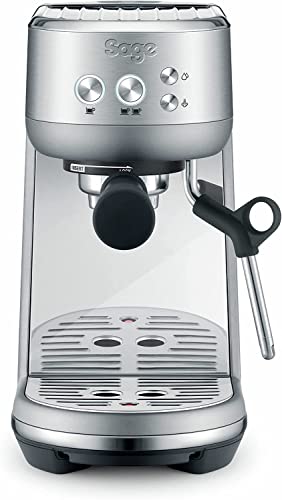Espresso Maker - A Must-Have For Home Baristas
Espresso is a strong, dark-brown drink made by forcing hot water through tightly packed, finely ground coffee. It is the base for many popular cafe drinks.
A skilled barista (also known as an espresso maker) manages a variety of variables to make an excellent cup of espresso. These include the temperature of the water, its pressure, and how tightly the coffee is packed.
Origins
The espresso machine is a device that makes use of high pressure to push small amounts of water near boiling through finely ground beans. The resultant beverage is stronger than drip coffee, more concentrated and served in smaller cups. It's a great option for those who love the taste of strong coffee but need it in a hurry!
The first espresso machines were invented in the 19th century. The coffee industry was huge in the 19th century however, brewing took a lot of time. People were impatient and wanted a quick cup of coffee!
Angelo Moriondo of Turin patented one of the first coffee machines in 1884. It held a name that was "New steam machinery for the economical and instantaneous preparation of coffee beverage, method A. Moriondo."
Luigi Bezzerra, Desiderio Pavoni and other Milanese manufacturers improved and adapted this machine. They added the portafilter along with a variety of brewheads and other innovations that are used in espresso machines today. The Ideale was their machine and it captivated the audience at the 1906 Milan Fair. Nine out of ten Italian homes have a Moka Pot.
Variations
Espresso's flavor is more concentrated than coffee, which is why it is a great match with milk and other ingredients to make popular coffee drinks like cappuccinos and lattes. Its bold flavor also shines in recipes for baked goods and even marinades.
There are four types of espresso machines: semi-automatic, super-automatic, manual lever and. Each type uses a different method to extract the espresso.
A manual lever machine employs a piston made of metal that presses water through the ground. It's the perfect compromise between the manual control and mechanized consistency. It's still necessary grind, tamp and pull the shot yourself however, you have a lot more control over the temperature and pressure.
Moka pots, another manual espresso maker, operate similar to modern espresso machines, which are powered by a pump. In an airtight tank boiling water produces steam, which is then forced through the bottom chamber, into a filter basket filled with ground coffee, and then into a filter made of metal, where it flows into the top cup. They're less expensive than full-sized espresso machine, but they're able to only hold up to 1-1.5 bars of pressure, which is lower than the ideal setting for brewing espresso.
Ingredients

Espresso makers can aid baristas in the home to make popular coffee drinks like lattes and cappuccinos. You can also add flavorful syrups or extracts to espresso shots to create an indulgence drink such as the espresso martini.
The most important ingredients for a great espresso cup are premium coffee beans, fresh milk and sugar. To ensure a consistent extraction, search for coffee beans that have a special espresso label. Grind them finely. Try different roasts until you find the one that is perfect for your taste.
You'll need a grinder to grind the beans into a uniform texture. The espresso machine also has a portafilter, which holds the grounds and a tamper, which is used to seal the coffee.
You'll also require an espresso cup set, as well as a steamer to make the silky aerated-milk characteristic of espresso drinks. Some machines have a steam wand that can make the process easier. You'll also need to descale your machine regularly, which involves running vinegar and water through the system.
Techniques
Espresso brewing relies upon creating pressure to quickly extract powerful flavors from finely-ground dark-roast and dark-roast beans packed into a "puck." This method of brewing makes a strong espresso shot known as espresso. When espresso is made properly it will have a rich crema that is topped with.
In contrast to the Moka Express that uses heat to filter water through coarsely ground coffee the majority of espresso makers use pressurized water pushed through small grounds under high heat. This produces an espresso-like beverage that can be dilute with milk or water to create other beverages such as cappuccinos and lattes.
While the Moka Express is a basic, low-cost appliance, other espresso machines are more complex, expensive, and offer many drink options. The most well-known lever machines are Italian-designed, and make use of a spring-loaded arm to pour hot water from the cylinder into a portafilter. The barista can adjust variables like water temperature as well as grind size shot by shot to achieve the most optimal results. These machines were instrumental in bringing espresso to greater prominence in Italy and Europe.
Equipment
A high-quality espresso maker needs to be able to separate soluble and insoluble solids from finely packed, tightly ground coffee. This process is made easier by the use of pressure and controlled variables, such as temperature and grind size. Then there's the flavor, which is dependent on a host of factors including the beans as well as the manner in which they're handled, as well as the way they're brewed.
There are a variety of espresso machines, but the semiautomatic is the most common. It uses an electrical pump to push the water through the grounds. The user can also perform the grinding and the tapping. These machines are among the most affordable, however they're not as consistent as spring pistons, or other designs made by hand.
The more expensive lever models come with a calibrated piston that does the work. They're more tolerant than spring piston machines, however, they require some experience to use properly. click through the up coming website require a lot of maintenance, which means you have to heat and de-assemble the portafilter and piston every time.
